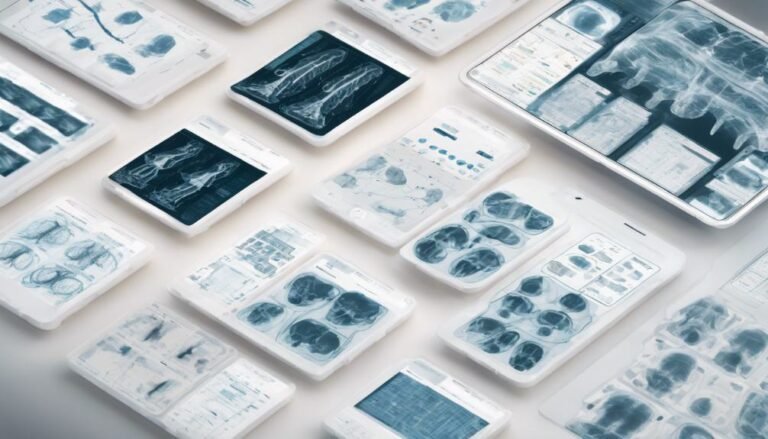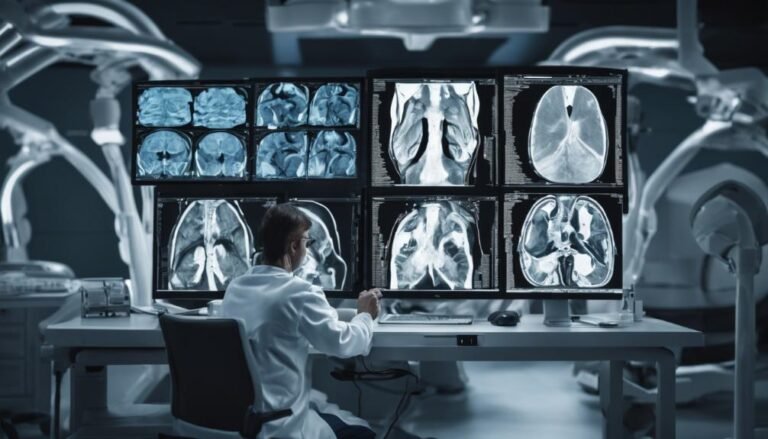AI in Rehabilitation
In the field of rehabilitation, AI is reshaping traditional approaches by introducing innovative methods that cater to individual needs and foster quicker recovery. Imagine a world where intelligent systems can predict your progress, adjust therapies in real-time, and offer simulations tailored to your unique requirements. The potential for AI to revolutionize rehabilitation practices is vast, promising better outcomes and a more personalized healing experience.
Key Takeaways
- AI-driven assessments aid in accurate diagnosis.
- Personalized treatment plans are enhanced with AI algorithms.
- Real-time adjustments optimize rehabilitation programs.
- Machine learning tracks progress for tailored therapy.
- Predictive analytics offer insights for outcome prediction.
AI Applications in Rehabilitation
Explore how AI is revolutionizing the field of rehabilitation by enhancing personalized treatment plans and accelerating recovery processes. AI-driven assessments are now being utilized to provide in-depth insights into patients' conditions, allowing for more accurate diagnosis and tailored treatment strategies.
Through patient progress monitoring, AI can track improvements or setbacks in real-time, enabling therapists to make timely adjustments to optimize outcomes.
Moreover, AI-powered interventions are transforming the way rehabilitation is conducted. These interventions use advanced algorithms to customize exercises and therapies based on individual needs, increasing the effectiveness of treatment.
Additionally, therapist support systems driven by AI offer valuable assistance by analyzing data trends, providing recommendations, and offering continuous support to clinicians throughout the rehabilitation process.
Virtual Reality in Therapy
Let's explore how Virtual Reality in Therapy can offer you immersive experiences that enhance your rehabilitation journey.
By engaging patients in interactive simulations, this technology boosts your motivation and commitment to therapy.
Additionally, personalized treatment scenarios cater to your specific needs, fostering a more effective recovery process.
Immersive Therapy Experiences
Immersive therapy experiences utilizing virtual reality have revolutionized the field of rehabilitation, offering innovative and effective ways to enhance patient outcomes and engagement. Through virtual reality, individuals can engage in activities that provide targeted sensory stimulation, aiding in the restoration of various functions. This immersive approach allows patients to interact with environments that simulate real-life scenarios, promoting cognitive training by challenging memory, attention, and problem-solving skills in a safe and controlled setting.
Virtual reality technology can transport you to different settings, whether it's a serene beach for relaxation or a bustling city for cognitive challenges. The customizable nature of virtual reality therapy enables tailored interventions that cater to individual needs, ensuring a personalized rehabilitation experience. By immersing yourself in these virtual environments, you can actively participate in your therapy, fostering a sense of empowerment and motivation towards your recovery journey.
The combination of sensory stimulation and cognitive training in immersive therapy experiences holds great promise for optimizing rehabilitation outcomes.
Enhanced Patient Engagement
How can virtual reality technology enhance patient engagement in therapy sessions for rehabilitation?
By offering interactive exercises and boosting patient motivation, virtual reality creates a dynamic and stimulating environment for therapy sessions. Through immersive experiences, patients can participate in interactive exercises that mimic real-life scenarios, making therapy more engaging and enjoyable. This engagement is vital for maintaining patient interest and encouraging active participation in their rehabilitation process.
Virtual reality technology can provide patients with a sense of agency and control over their therapy, which can greatly increase their motivation to complete exercises and reach their rehabilitation goals. By incorporating gamification elements, such as rewards and challenges, virtual reality therapy can make the rehabilitation process feel more like a game, motivating patients to push themselves further.
Personalized Treatment Simulations
Virtual reality technology in therapy allows for the creation of personalized treatment simulations tailored to your individual needs and goals. By utilizing custom exercises and virtual environments, you can experience therapy in a way that's specifically designed to address your unique challenges. These personalized treatment simulations provide a tailored approach to rehabilitation that takes into account your specific requirements, making the therapy more effective and engaging.
In these virtual environments, you can receive real-time feedback based on your movements and interactions, enhancing your understanding of the exercises and promoting better outcomes. The sensory feedback provided by virtual reality technology immerses you in a simulated world where you can practice and improve without the limitations of traditional therapy settings.
Robotics for Enhanced Recovery
Utilizing robotic technology in rehabilitation programs can greatly enhance the recovery process for individuals with physical impairments. Robot assisted exercises provide precise and controlled movements that target specific muscle groups, aiding in strength building and coordination.
These exercises, guided by robotic feedback systems, offer real-time data on performance, helping individuals and therapists track progress and adjust the rehabilitation plan accordingly.
The incorporation of robot assisted exercises ensures that each movement is carried out with accuracy and consistency, minimizing the risk of injury and maximizing the effectiveness of the rehabilitation process. The robotic feedback systems provide valuable insights into the individual's performance, offering a detailed analysis of their movements and progress over time.
Personalized Treatment Plans
Tailoring treatment plans to meet the specific needs and goals of each individual is essential in maximizing the effectiveness of rehabilitation programs. Customized interventions play a pivotal role in addressing the unique requirements of patients undergoing rehabilitation. By utilizing AI algorithms and data analytics, healthcare providers can design tailored programs that cater to the individual's condition, preferences, and progress.
Personalized treatment plans offer a more targeted approach to rehabilitation, ensuring that each therapy session is optimized for the patient's benefit. These tailored programs take into account factors such as the individual's medical history, current physical abilities, and personal objectives.
Through the use of AI algorithms, healthcare professionals can analyze vast amounts of data to create interventions that are most likely to yield positive outcomes for the patient.
Data Analysis for Progress Tracking
You can rely on progress tracking algorithms to monitor your rehabilitation journey effectively.
These algorithms use machine learning insights to provide you and your healthcare team with valuable information on your progress.
Progress Tracking Algorithms
As rehabilitation programs increasingly rely on technology, progress tracking algorithms play an essential role in analyzing data to monitor and assess individuals' advancements accurately. These algorithms not only track progress but also provide valuable insights through advanced analytics and outcome prediction. By utilizing machine learning techniques, progress tracking algorithms can detect patterns in the data, allowing for a more thorough evaluation of an individual's rehabilitation journey.
Through the integration of advanced analytics, these algorithms can predict potential outcomes based on past data, enabling healthcare providers to tailor treatment plans to each individual's specific needs effectively. By tracking progress in real-time and continuously analyzing the data, these algorithms offer a detailed view of the rehabilitation process, empowering both individuals and healthcare professionals with valuable insights to optimize treatment strategies.
In essence, progress tracking algorithms serve as an important tool in rehabilitation, offering a data-driven approach to monitoring progress, predicting outcomes, and guiding personalized treatment plans for improved patient outcomes.
Machine Learning Insights
Utilizing machine learning techniques, data analysis for progress tracking in rehabilitation programs offers valuable insights through advanced analytics and outcome prediction. By harnessing the power of predictive analytics, healthcare providers can gain a deeper understanding of patient outcomes and tailor treatment plans for better results. Machine learning algorithms play a crucial role in analyzing vast amounts of data collected during rehabilitation sessions, identifying patterns, and forecasting potential outcomes.
With machine learning, rehabilitation progress can be monitored more effectively, allowing for real-time adjustments to therapy programs based on individual responses. These insights enable healthcare professionals to personalize care, optimize interventions, and enhance patient recovery. By leveraging predictive analytics, providers can anticipate challenges, track improvements, and measure the efficacy of different rehabilitation approaches.
Incorporating machine learning into progress tracking not only streamlines the monitoring process but also empowers clinicians with data-driven decision-making tools. Through continuous analysis and interpretation of patient data, rehabilitation programs can evolve to better meet individual needs and improve overall outcomes.
Rehabilitation Outcome Analysis
By analyzing rehabilitation outcomes through data tracking and analysis, healthcare professionals can gain valuable insights into patient progress and tailor treatment plans for best results.
Rehabilitation metrics, such as range of motion improvements, pain levels, and functional abilities, are essential for evaluating the effectiveness of interventions. Through predictive analytics, patterns in patient data can be identified to aid in outcome prediction and optimize rehabilitation strategies.
Data visualization plays a key role in presenting complex rehabilitation data in a clear and understandable manner. Visual representations of trends and progress over time can help both healthcare providers and patients track improvements and set realistic goals.
By utilizing advanced technology for outcome analysis, rehabilitation teams can make informed decisions and adjustments to treatment plans, leading to better outcomes for patients.
Incorporating predictive analytics into rehabilitation practices enhances the ability to anticipate patient progress and adjust interventions accordingly. By leveraging data-driven insights, healthcare professionals can personalize treatment approaches, ultimately improving rehabilitation outcomes and enhancing patient well-being.
Benefits of AI in Healing
Harnessing the power of artificial intelligence in healing processes can greatly enhance the rehabilitation journey for individuals recovering from various health conditions. AI-driven recovery strategies offer personalized therapy simulations that cater to your specific needs, maximizing the effectiveness of your rehabilitation.
By integrating virtual reality experiences into healing with AI, you can engage in immersive activities that promote physical and cognitive recovery in a stimulating yet controlled environment.
AI in healing provides a tailored approach that adapts to your progress, making real-time adjustments to optimize your rehabilitation program. This personalized feedback loop guarantees that you're constantly challenged at the right level, accelerating your recovery process.
Through AI-driven recovery strategies, you can access a wide range of exercises and activities customized to your abilities and goals, empowering you to take an active role in your healing journey.
Embracing the benefits of AI in healing not only enhances the effectiveness of rehabilitation but also fosters a sense of empowerment and progress as you work towards regaining your health and well-being.
Future Trends in Rehab Technology
As the landscape of rehabilitation evolves, exploring the future trends in rehab technology becomes pivotal for staying at the forefront of innovative healing methodologies.
One significant trend shaping the future of rehab technology is the integration of wearable devices. These devices offer real-time data on patient movements, allowing for more personalized and precise rehabilitation plans tailored to individual needs. By leveraging wearable technology, healthcare providers can track progress more accurately, leading to improved rehabilitation outcomes.
Another key trend on the horizon is remote monitoring of patient progress. Through telehealth solutions and remote monitoring tools, healthcare professionals can keep a close eye on patients outside traditional clinical settings. This enables continuous assessment of patient performance, timely intervention in case of setbacks, and overall better management of the rehabilitation process.
Remote monitoring not only enhances patient care but also promotes greater independence and confidence during the recovery journey.
Conclusion
As you navigate your rehabilitation journey, AI serves as your personal guide, offering tailored support and insights to accelerate your recovery.
Like a skilled navigator guiding a ship through rough waters, AI in rehabilitation charts a course for success, adjusting to your progress and steering you towards healing.
Embrace this transformative technology as your trusted companion on the path to a stronger, healthier you.







